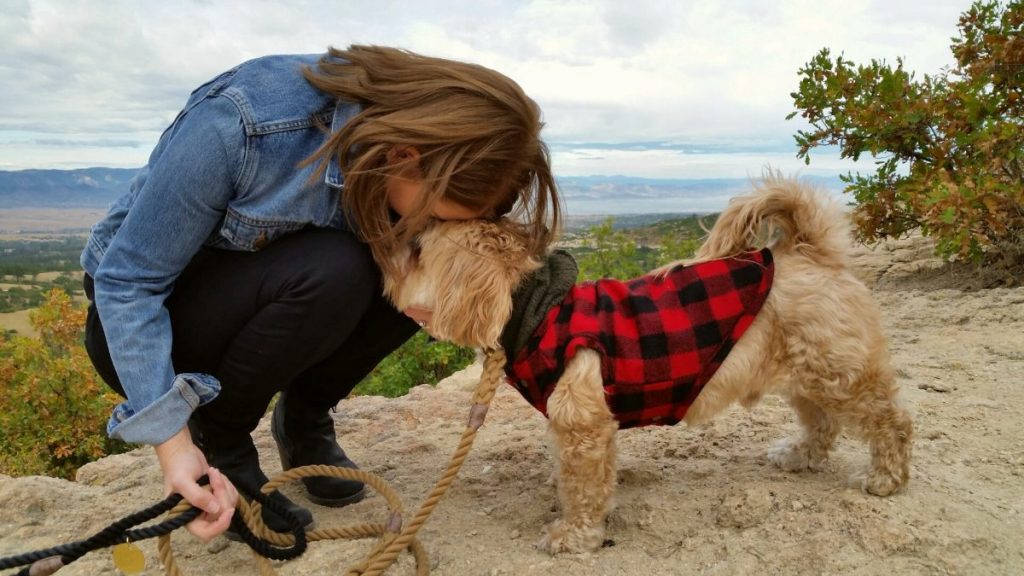How do I train my dog to be an emotional support animal? It’s a question I often get from pet owners looking to certify their dogs as ESAs. As a result, clarifying certain aspects of ESAs while offering guidance about their needed skills was necessary. So let’s begin by outlining what special training if any, a dog needs before becoming one.

Does an Emotional Support Animal Require Training?
Emotional support animals don’t need specialized training. It’s a significant difference between ESAs and service dogs, which require extensive training to gain specific abilities. After all, service dogs have to perform particular tasks vital to helping their handler’s condition.
So what does a dog need to become an ESA? Well, it boils down to their owners having an ESA letter from a mental health professional. In addition, the dogs must be well-behaved, controllable, and not a safety risk to others.
I’d also recommend spaying and neutering any emotional support dog. It’s been well-documented that these procedures minimize certain aggressive behaviors. Plus, it’s another thing you don’t have to worry about when traveling in public places with your ESA.
How to Train a Dog As An Emotional Support Animal
In general, having a dog around will help relieve anyone’s discomfort or stress. It certainly puts a smile on my face whenever I see my dogs after a hard day. But a well-behaved emotional support dog can provide more structure and focus in your life.
For instance, these animals can help people deal with loneliness or social anxiety in public places. They can provide a steady, comforting hand whenever you might need it. These ESAs are lifesavers when adequately trained.
However, it’s essential to realize that these animals are allowed in areas most aren’t. So the word well-behaved takes on a new meaning with them. You need to provide them with the training necessary to ensure they don’t produce a stressful or chaotic situation.
How does a person provide this training? As you know, there are several ways to train dogs with varying levels of effectiveness. My primary advice is to pick one, create a routine, and don’t stray from it unless necessary.
Another thing to consider is training a dog takes a significant amount of time. Your dog isn’t going to learn everything in one or two 30-minute training sessions. Instead, it’ll be a daily process to ingrain these skills into their brains.
Furthermore, refrain from using punishment-based methods to train your dog. These sessions will only cause your dog to fear and resent you. Instead, stick with positive reinforcement that focuses on providing rewards for good behavior.

6 Vital Skills to Teach Your ESA Dog
After deciding on your training method, it’s time to consider some necessary ESA skills. I must admit that some of them may seem a little bare, or you’ve already accomplished them. But each skill is vital to ensuring your dog’s the best ESA!
1. House Training
Well-behaved emotional support dogs shouldn’t be relieving themselves indoors. It might seem like common sense, but you’d be surprised by how owners take ESAs into indoor public places without making sure they’re housebroken.
Given this info, please ensure your dog won’t use a grocery store as a urinal. It’ll just create a stressful and awkward situation for everyone involved. Instead, take the time to master their house training before taking them everywhere.
This training can take several months with some dogs, especially with puppies. But it shouldn’t be too difficult as many traditional methods work well with most pups. So grabbing some puppy pads and taking them out on a regular schedule should get the job done.
If you want to advance their training, teach them to alert you when it’s potty time. Most experts recommend using a bell as the alert system. Here’s a well-detailed video to guide you through this process.
2. Sit
Dogs with ESA letters need to know basic obedience commands, such as sitting on cue. This action makes traveling with your ESA companion a lot more convenient. Plus, it helps you calm them down in a tense scenario by having them focus on command.
The training process itself isn’t too tricky. If you follow these four steps, your dog should be sitting like a pro in no time:
- Choose a treat that your dog loves. Then, hold it at your dog’s nose level while he’s in a standing position.
- Say “sit” while moving the treat up and over his back. You’ll notice your dog’s head will tilt up until he eventually sits.
- After he’s sitting, give him praise by saying “good job” or “good boy” in a friendly tone. It’ll teach him that it’s a good behavior through positive reinforcement.
- Repeat the process until it’s automatic. But stretch out the training process over several days to avoid giving your dog too many treats.

3. Stay
Another primary obedience training objective is teaching your ESA how to stay. It’ll help you manage impulse control and keep them safe in dangerous situations. Here’s a quick step-by-step guide to help you through the teaching process:
- Start by commanding your ESA to sit. Then, open your palm toward the dog to offer them a visual cue.
- Put space between you and the dog by stepping away slowly. At the same time, command your dog to “stay” while moving away from them.
- Call your dog over by using the command “come” while closing your hand. Of course, you don’t want them to come. So if they stay, reward them with their favorite treat.
- Start the process over if they come over to you. You should then repeat the process until your dog gets it completely.
Check out the video below for tips on how to teach your dog to sit and stay:
4. Paw
Our next training command is more about bonding with your ESA. Teaching your dog to give you its paw is a fun learning experience for both involved parties. It’s an easy way to further encourage these training sessions after learning “sit” and “stay.”
Luckily, the learning process doesn’t require too much effort. Knowing how to “sit” is half the battle with this 4-step training exercise:
- Start by commanding your dog to sit. Reveal the treat in your hand and close your first, but make sure your dog knows you have it (let them smell it).
- Wait until your dog attempts to lift their paw to retrieve the treat from your hand. Once they do, take their paw and praise them for it.
- You can now give them the treat. Repeat the process until your dog understand this action gets them a reward.
- Next, introduce the command “paw.” Say it when you close your fist, and they start lifting their paw. Please repeat this step until your dog understands that lifting their paw and the command get them a treat.
Here’s a good visual tutorial:
5. How to Walk on a Leash Properly
Proper leash walking is a fundamental aspect of being a well-behaved ESA. After all, your dog pulling on the leash or harness only creates chaos and stress. You’ll want to curb pulling and other problematic walking behaviors like chewing.
Loose leash walking training is a simple way to achieve proper leash walking. It’ll teach your dog to walk ahead with a bit of slack or in a heel position behind you. Both places will work fine as it’s a preferred choice for each owner.
In any case, I’d recommend starting this training in a low-stress environment. A perfect setting would be somewhere familiar without too many distractions, like your backyard. Here’s a detailed video on how to train your dog with loose leash walking training.
6. Recall Lessons
Your ESA must know how to run over to you when they’re called. In other words, your dog needs top-tier recall skills when functioning in an ESA capacity. It’s one of the primary ways to de-escalate a difficult or dangerous situation.
As for the training process, recall lessons will take significant time and patience to master. It’s much like house training concerning how much easier it is with specific breeds. But you’ll see the best results using a positive reinforcement method that includes treats when your dog’s called.
Your dog will then associate the recall command with yummy treats. Essentially, you’re tricking their minds by giving them rewards. Over time, your dog will understand that being next to you is the best way to get what they want.
Check out this video for more tips:
Conclusion
Training a dog to be an emotional support animal is all about ensuring you can control their impulses. You must know they will stay, sit, come, or walk properly whenever required. It’s also imperative that they’re housebroken and don’t relieve themselves in problematic areas.
But these commands have to be learned through positive reinforcement. Otherwise, the training sessions could cause resentment to form within your dog. This resentment will only increase when faced with stressful or chaotic environments that ESA often frequent.
Have you trained your dog to be an emotional support animal? Share your thoughts and experiences below!

